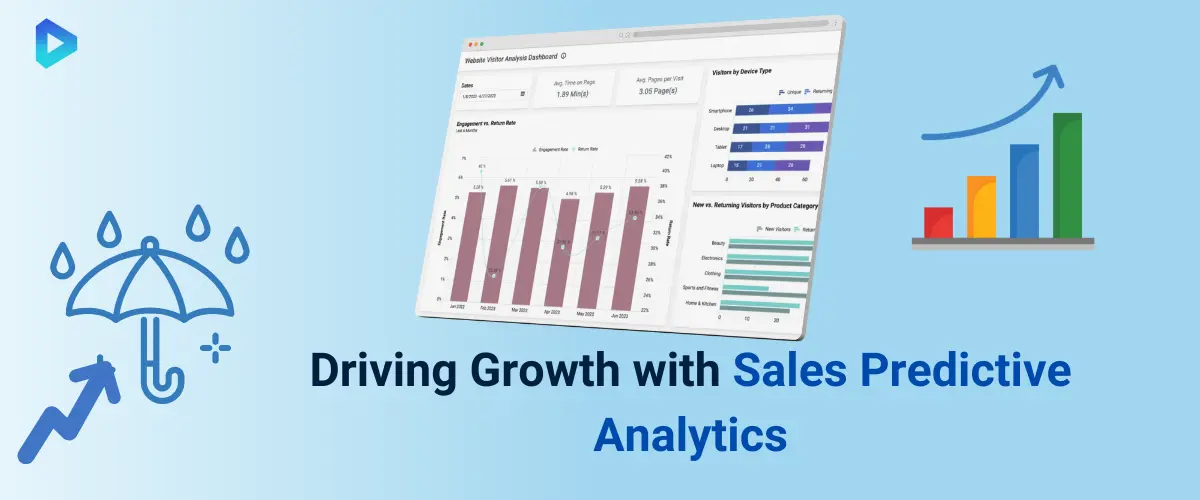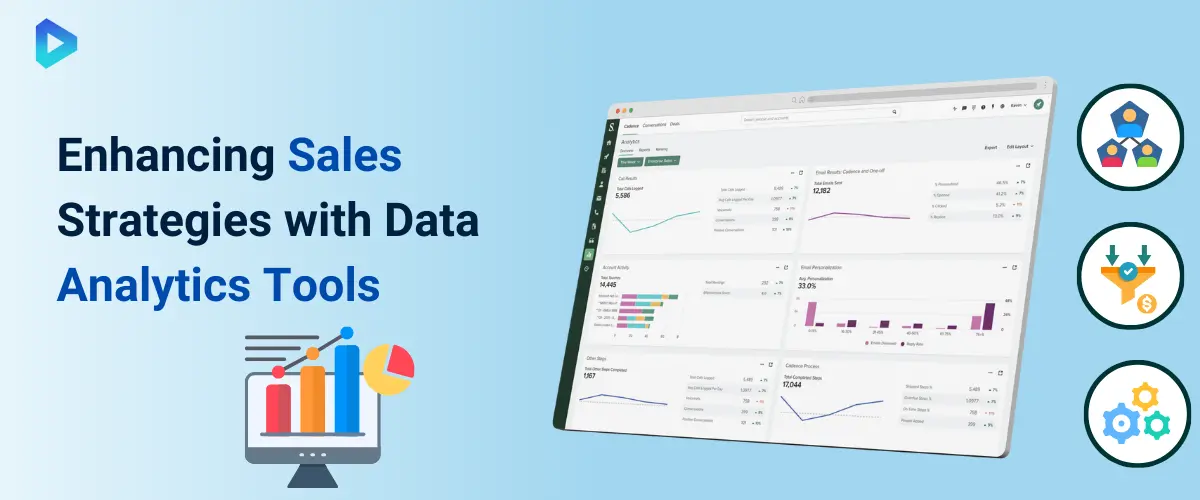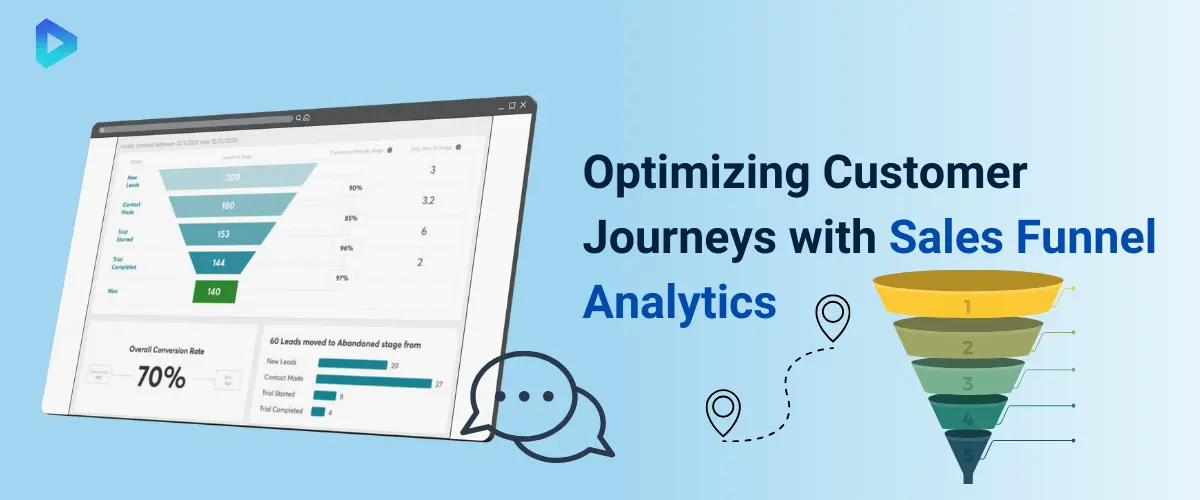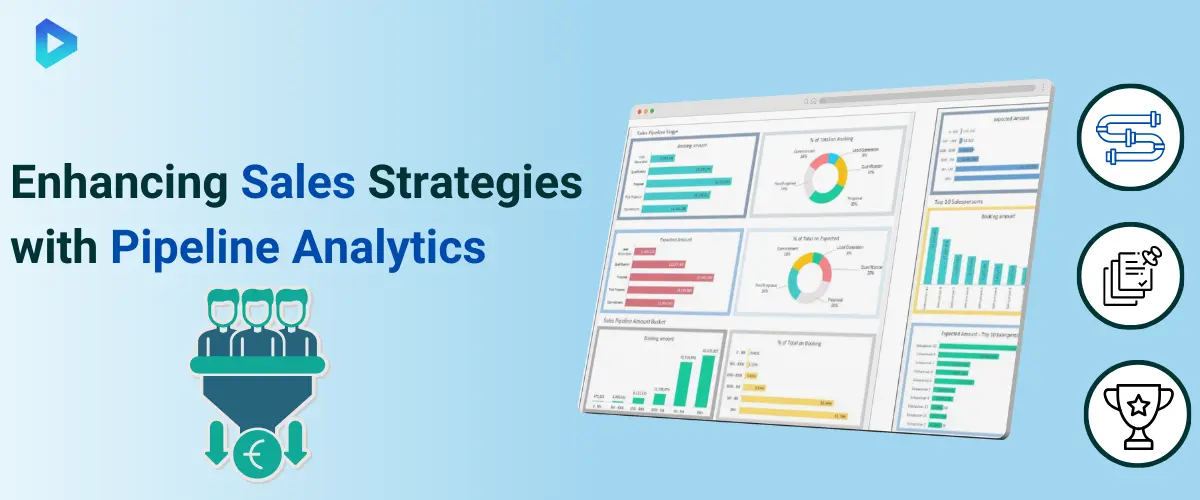
How to Improve Enterprise Efficiency with SaaS ERP Solutions?

Published on: October 28, 2024 Data Analytics
Are you finding it challenging to unlock your business’s full potential? Are you searching for a way to outperform your competitors and achieve unprecedented success? Look no further than Sales Analytics. In today's competitive marketplace, businesses can no longer rely on intuition and guesswork when making strategic decisions. Sales analytics provides valuable insights and data-driven solutions to help you make informed choices and drive business growth. This powerful tool empowers businesses to optimize their sales processes, improve customer satisfaction, and increase revenue. From identifying the most profitable customer segments to optimizing pricing strategies, sales analytics can help revolutionize your business. In this blog, we will explore how sales analytics can supercharge your business success.
Sales predictive analytics empowers businesses to strategize for sustainable growth by forecasting market trends.

Sales predictive analytics is a technique used to forecast future sales outcomes based on historical data. It identifies potential trends and customer behavior patterns, enabling businesses to make data-driven decisions. Key components include data collection, analysis, and predictive modeling. With accurate forecasting, companies can allocate resources more effectively and set realistic targets.
Benefits of Predictive Analytics:
Incorporating predictive analytics strengthens decision-making, driving efficiency and customer satisfaction.
Predictive analytics pinpoints sales trends by examining historical customer data, seasonal patterns, and market conditions. By identifying high-demand periods or declining product interest, businesses can proactively adjust their strategies. This approach minimizes inventory wastage and helps businesses target the right audience at the right time.
Key Trends Predictive Analytics Can Identify:
Predictive analytics transforms raw data into actionable insights, allowing sales teams to refine their approaches and improve conversion rates.
Integrating predictive analytics into sales strategies enables businesses to create proactive sales plans. By using data to guide decisions, companies can anticipate market shifts, align offerings with customer needs, and achieve long-term growth. Integration can be achieved by combining CRM systems with analytics tools to track and apply insights to daily operations.
Steps for Integration:
With predictive analytics, sales teams become more agile, responding quickly to shifts and maximizing profitability.
Tools for sales data analytics simplify data interpretation, empowering businesses to make informed, data-backed decisions.

Sales data analytics tools bring accuracy and efficiency to sales performance tracking and forecasting. Top tools in this category offer comprehensive dashboards, real-time insights, and integration capabilities that help businesses stay agile. Notable examples include Tableau, Microsoft Power BI, and Salesforce Einstein Analytics. These tools visualize complex data, track sales trends, and enable accurate forecasting.
Key Features of Leading Tools:
Choosing the right tool is crucial for precision, as it supports data alignment across departments, streamlining sales decisions with trustworthy insights.
Integrating sales data analytics into business strategy provides a foundation for more precise decision-making. By embedding analytics into daily processes, businesses can identify which strategies work best, anticipate market needs, and understand customer behaviors. Sales analytics integration involves setting up KPIs, training teams, and using real-time dashboards to track performance.
Steps for Effective Integration:
Through data integration, companies can connect the dots between customer needs and sales tactics, driving meaningful outcomes and supporting long-term growth.
Data-driven insights support better decision-making by providing a clear understanding of market trends and customer behaviors. With accurate sales data at their fingertips, leaders can pivot quickly, respond to demand changes, and enhance customer engagement. Businesses benefit from tools that offer robust analytics, transforming raw data into insights for improved strategic decisions.
Benefits of Data-Driven Decision-Making:
Utilizing data insights helps companies navigate complexities and refine strategies, maximizing their competitive edge in evolving markets.
Sales funnel analytics offers clear insights into customer journeys and conversion paths.

Sales funnel analytics helps businesses understand each stage of the buyer’s journey—from awareness to purchase. By examining each stage of the funnel, companies can pinpoint where prospects lose interest and where engagement peaks. Insights into stages such as “awareness,” “consideration,” and “decision” allow businesses to tailor content and approach to guide customers toward conversion.
Key Stages in the Sales Funnel:
With analytics at each stage, businesses can refine their approach, ensuring a smooth customer journey and a more predictable conversion rate.
Sales funnel analytics enhances conversions by identifying weak points and strengths within the customer journey. By tracking metrics such as drop-off rates, time spent at each stage, and conversion rates, businesses gain valuable insights into what’s working and what needs improvement. These insights enable targeted adjustments, such as optimizing calls-to-action, enhancing website speed, or personalizing content.
Conversion-Driving Factors to Track:
Implementing changes based on analytics ensures each stage of the funnel is optimized to convert, ultimately leading to higher revenue and a stronger customer base.
Optimizing the sales funnel requires a data-driven approach, ensuring that each touchpoint aligns with customer expectations. Key practices include segmenting customers based on behaviors, continuously testing content, and aligning marketing with sales. Regular analysis also reveals opportunities to shorten the sales cycle and improve messaging at each funnel stage.
Sales Funnel Optimization Tips:
By implementing these best practices, businesses can create a seamless, effective sales funnel that adapts to customer needs and maximizes conversion potential.
Sales pipeline analytics provides crucial insights to streamline pipeline management and boost sales outcomes.

Tracking the right metrics in sales pipeline analytics reveals critical insights into the health and progress of the sales process. Metrics like pipeline velocity, lead conversion rates, deal win/loss ratios, and average deal size help gauge sales performance. By understanding these figures, sales teams can prioritize high-value leads and adjust strategies to maximize conversions.
Essential Pipeline Metrics:
Monitoring these metrics regularly ensures that sales strategies remain aligned with goals and optimized for success.
Pipeline analytics empowers sales teams to identify and remove bottlenecks, making the sales process more efficient. By analyzing pipeline stages, teams can streamline workflows, focusing on high-potential leads and enhancing engagement at critical touchpoints. This data-driven approach enables efficient resource allocation, ensuring sales teams spend time where it matters most.
Efficiency-Boosting Techniques:
Using pipeline analytics in this way allows businesses to close deals faster and maintain momentum across all stages of the pipeline.
Sales pipeline insights play a vital role in shortening the sales cycle, ensuring that deals progress swiftly. By analyzing each stage, teams can detect patterns and identify where delays are occurring. Addressing these issues early prevents leads from stagnating, keeping the sales cycle on track and improving customer experience.
Strategies for Cycle Time Reduction:
These adjustments help move leads through the pipeline more quickly, reducing cycle time and leading to faster revenue realization for the business.
Sales performance analytics empower teams to enhance efficiency and drive measurable growth.
![]()
Tracking key sales performance metrics allows teams to gain actionable insights that drive success. Metrics like individual and team sales targets, close rates, average deal size, and time to close are essential in understanding what’s working and what’s not. With detailed performance metrics, managers can identify high performers, spot areas for improvement, and implement strategies that encourage consistent growth.
Key Metrics to Track:
These metrics provide a roadmap for optimizing sales strategies and achieving higher performance levels across the team.
Performance analytics streamline workflows and enable teams to maximize productivity by identifying bottlenecks and areas for improvement. With real-time insights into efficiency metrics like response times, follow-up consistency, and deal progression, sales managers can fine-tune team activities to align with high-impact strategies. By doing so, teams can focus on effective selling techniques that yield the best results.
Strategies to Improve Efficiency:
Performance analytics ensure that each team member’s efforts contribute to seamless, efficient operations.
Aligning sales performance analytics with business goals fosters a unified vision, allowing sales teams to drive results that contribute directly to organizational objectives. Metrics such as revenue targets, customer acquisition rates, and customer satisfaction scores should be tracked to ensure alignment. Regularly reviewing and adjusting analytics in line with these goals helps teams stay focused on high-priority activities, reinforcing overall business success.
Goal-Alignment Tactics:
By syncing analytics with business goals, teams can stay aligned with broader objectives and work cohesively toward sustained growth.
Sales volume analysis drives strategic decisions for improved growth and competitive advantage.

Sales volume analysis is critical for refining business strategy and providing insights into product performance and market demand. By examining sales volumes over time, businesses can pinpoint trends, identify high-performing products, and recognize underperforming ones. This analysis enables companies to adjust inventory, allocate resources effectively, and set more accurate revenue goals, all of which contribute to a targeted growth strategy.
Benefits of Volume Analysis:
Sales volume analysis strengthens strategic decision-making by aligning business efforts with market needs and consumer demand.
Accurate volume analysis relies on effective tools and methods that capture and evaluate sales data. Businesses commonly use customer relationship management (CRM) platforms, data visualization software, and predictive analytics tools to gather insights. Techniques such as time-series analysis, cohort analysis, and benchmarking allow companies to measure performance against goals and industry standards, offering a comprehensive view of sales volumes.
Popular Tools:
Combining these tools and techniques helps companies maintain a competitive edge with in-depth, reliable sales insights.
Leveraging sales volume analysis helps companies optimize product lines and offerings based on consumer demand. By identifying which products drive the most sales, businesses can prioritize high-performing items, adjust pricing strategies, or create bundles that appeal to customers. Additionally, volume analysis can reveal seasonal or regional variations in demand, allowing for tailored marketing and distribution strategies that boost sales potential.
Optimization Strategies:
Sales volume analysis ensures that product offerings align with customer preferences, maximizing growth opportunities and profitability.

How to Improve Enterprise Efficiency with SaaS ERP Solutions?

Why Operational CRM is Essential for Customer Satisfaction?

Why Mobile Web App are Essential for Your Supply Chain Business?

Where to Start with Advanced Analytics in Your Enterprise?